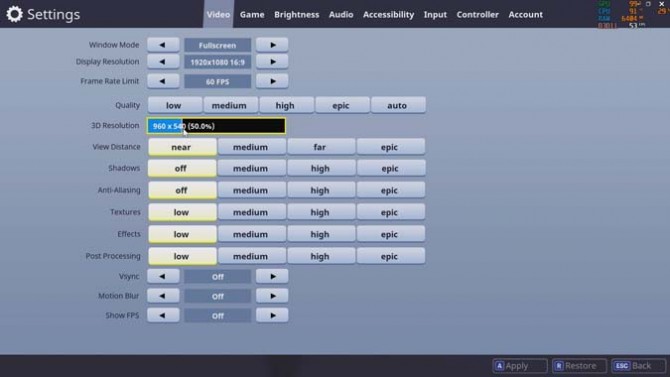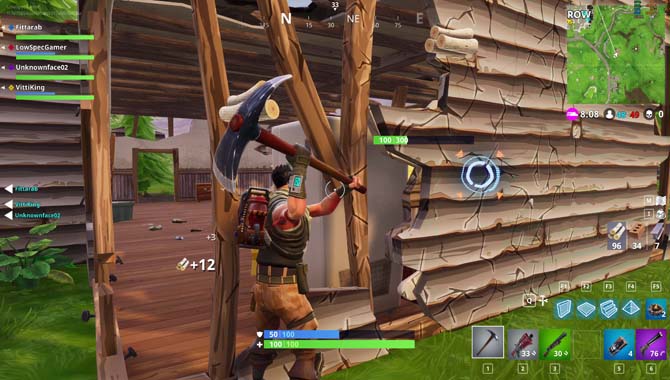What Kind of Laptop Do You Need for Fortnite?
If you are gamer, you have probably played Fortnite: Battle Royale. If you are a person on the internet, you have likely at least heard of it.
The 100-player free-to-play battle royale game shows no sign of slowing down. If you are yet to jump in, what sort of laptop do you need to start? Or, if you are thinking of upgrading, what improvements can you expect on a better gaming laptop?
To find out, I ran a series of tests on a general-use machine with integrated graphics, an ultrabook with low-end Nvidia MX150 graphics, an entry-level gaming laptop with a Nvidia GTX 1050 Ti card, a high-end laptop with GTX 1060 graphics and a premium mobile gaming device with a GTX 1070 on board.
| GPU | Best Resolution | Settings | FPS |
| Intel HD 620 (Dell XPS 13) | 960 x 540 | Low | 60 fps |
| Nvidia MX150 (Xiaomi Pro) | 1920 x 1080 | Low | 60 fps |
| Nvidia GTX 1050Ti (MSI GL62M-7REX) | 1920 x 1080 | Epic | 60 fps |
| Nvidia GTX 1060 (Alienware 15 R3) | 3840 x 2160 | Low/Medium | 60 fps |
| Nvidia GTX 1070 (Alienware 15 R3) | 3840 x 2160 | Medium | 60 fps |
Fortnite Battle Royale on Intel HD graphics
Fortnite runs on the Unreal Engine 4. The game is an example of Epic Games' mastery of the Unreal Engine (which the company created). The minimum requirements are way under what you would expect of a modern game release:
- Intel HD 4000
- Core i3 2.4 Ghz
- 4 GB RAM
And the game can be made to work pretty smoothly on a device close to those requirements with the proper adjustments.
In this specific test, I used a Dell XPS 13 9360 from 2017 with an Intel Core i7-8550U, Intel UHD Graphics 620 and 8GB of RAM.
Sign up to receive The Snapshot, a free special dispatch from Laptop Mag, in your inbox.
MORE: Best Graphics Performance
With all the settings on the lowest, the next step was to reduce internal resolution using the "3D resolution" slider. It is generally advisable to reduce internal resolution rather than changing the external resolution of the whole game, as the former will not affect text readability and will be sampled back to full resolution, which can look just a bit better.
With a 3D resolution of 50 percent (so a practical resolution of 960 x 540), the game performs somewhere between 40 to 50 frames per second (fps) when loading the whole map (such as when you're jumping out of the bus). But the game quickly goes back to around 60 fps once you hit the ground and run around the map.
Considering that we are using low-end integrated graphics, this is a very impressive result. In other games, (such as Far Cry 5) the low internal resolution might be problematic for understanding the game but Epic clearly spent a lot of effort making sure Fortnite remains readable in a variety of conditions. The blurriness is rarely, if ever, a problem.
Verdict: You can play Fortnite on a modern Intel HD iGPU on the lowest settings. The game performs extremely well.
How can a dedicated GPU improve the experience?
Fortnite Battle Royale on Low-End, Nvidia MX150 Graphics
The MX150, a mobile variant of the GT 1030, is Nvidia's current low-end dedicated GPU for laptops. It is meant to provide boosted graphical capabilities superior to those of an integrated GPU. For this test, I used an imported Xiaomi Pro with a i5-8250U quad-core CPU, 8GB of RAM and the MX150.
With this extra power, we can jump to full 1080 resolution at 100 percent 3D Render Resolution and on generally the lowest settings. Since the GPU still has some breathing room and the 2 GB of VRAM is underutilized, anti-aliasing and textures can be increased to medium.
While the game does look a bit bland on the lowest settings, playing on full 1080p resolution with anti-aliasing provided a crisp and clear image at any distance. The extra texture resolution is noticeable in objects up close.
Unfortunately, it was not possible to enable B-sync, even on the lowest settings, without having regular stuttering.
Verdict: A great experience with solid 60 fps on 1080p and medium settings with Anti-Aliasing and textures.
Fortnite Battle Royale on a Budget, GTX 1050 Ti Gaming Laptop
The next step on our journey is a GTX 1050 Ti, a mid-end Nvidia GPU commonly found in entry-level gaming laptops. For this test, I used the MSI GL62M-7REX with a Core i7-7700HQ CPU, 8 GB of DDR4 RAM and a GTX 1050 Ti GPU with 4GB of VRAM.
The game scales dramatically, with almost all settings reaching ultra with motion blur and V-Sync enabled. The only exceptions here are post-processing and shadows, which had to remain on high. Shadows, in particular, are a performance killer at this level, and rising them to ultra would drop performance consistently between 40-50 fps.
MORE: Highest Resolution Screens
However, the fact remains that most of the settings are close to maxed out and it shows during the game. The water in the distance is realistic, the terrain is colorful and detailed and high-quality textures and post-processing envelop everything in a whimsical ambience.
Fortnite can be a really nice-looking game, and it does not take much to get there. Even a regular, non-Ti GTX 1050 can likely get solid 60 fps performance on high settings.
Since Fortnite's 50 vs 50 mode was available at the time of writing, I decided to try it as a makeshift intensity test, since it forces a large number of players to engage in combat in a small space. The GTX 1050 Ti managed to maintain a solid 55-60 fps average with no issues.
Verdict: Sixty fps at 1080p with nearly maxed-out settings on an entry-level gaming laptop makes for a great experience. Shadows remain on high to maintain the frame rate but the change is barely noticeable.
Fortnite Battle Royale on a GTX 1060 Laptop
Now we test with a beefy Alienware 15 R3 with a Core i7-7700HQ CPU, 8GB of RAM and a Nvidia GTX 1060 GPU.
Given the results of the GTX 1050 Ti, it is not a surprise that the GTX 1060 can max out all the settings at 1080p and maintain 60 fps with no difficulty and plenty of space to spare.
Apart from some better shadows, the experience is similar to what was provided on the GTX 1050 Ti, so a laptop with an equivalent GPU is enough if your objective is to play the game on very high settings. The GTX 1060 might be overkill for 1080.
So, let's try the game on 4K.
Fortnite's miraculous optimization comes through again. On a resolution of 3840 x 2160, with shadows disabled, post-processing at low, and anti-aliasing disabled (note: anti-aliasing tends to be less necessary on higher resolutions) but textures, effects and view distance at medium, the game maintains a near 60 fps average through a match.
The lack of shadows is the most notorious sacrifice in these settings, but if you are going for pixel count, the GTX 1060 is perfectly able to provide 60 fps at 4K.
Verdict: Overkill for highest settings on 1080p/60 fps. Manages 4K/60 fps with a mixture of low and medium settings.
Fortnite Battle Royale on a GTX 1070 Laptop
Now we switch to yet another Alienware 15 R3, which had a Core i7-7820HQ, 16GB of RAM and a mighty Nvidia GTX 1070 GPU. It is obvious that it can do the game on the highest of settings in 1080p without breaking a sweat. Will this be enough for higher quality in 4K?
What I managed was medium settings, but textures on high. During the worst moments, the GPU was working to the fullest but the 60 fps average was maintained.
This is a marked improvement over the low settings, and strikes a nice balance for 4K gaming. Very impressive and enjoyable!
Verdict: extreme overkill for highest settings at 1080p. Perfectly capable of medium settings at 4K/60 fps. Fantastic for portable 4K gaming.
Bottom Line
Fortnite is a testament to the amazing scalability of a modern engine combined with excellent design.
The game's low minimum requirements mean that a modest laptop with modern Intel HD graphics will be capable of playing the game with a good performance at lower settings and lower resolution. Even if the experience is not ideal, the visual design means that the game is easy to read at all resolutions.
If you have access to a laptop with a low-end dedicated GPU, the game scales appropriately, allowing for a full 1080p/60 fps experience on medium settings. The game will look great and perform flawlessly.
A laptop with a GTX 1050 Ti will be able to almost max out the game at 1080p, with shadows being the main exception. The game looks absolutely fantastic and performs perfectly. This provides the best experience for the money.
A laptop with a GTX 1060 is overkill for 1080p but can do 60 fps on 4K on a mixture of low and medium settings.
If 4K is a must, then a laptop with a GTX 1070 is able to provide 60 fps on medium settings, which it maintains even on the heaviest moments.
Credit: Laptop Mag
















